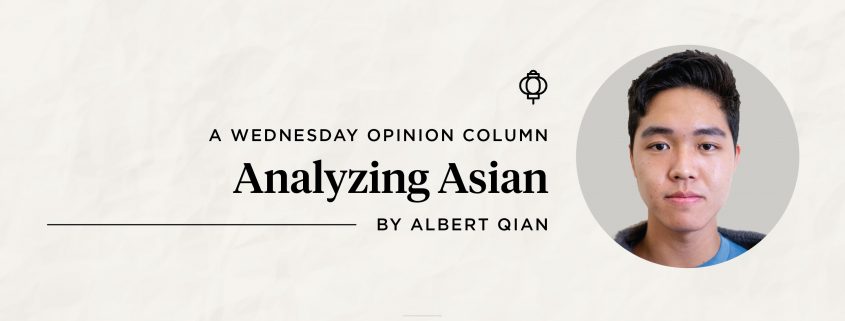Analyzing Asian: Television diversity quotas do only the bare minimum
I often wonder what it’s like to meet a diversity quota as a writer for a television show — to be stuck in the situation of needing to appear racially progressive for ratings, but never actually commit. I imagine it’s a bit like recruiting for a college admissions pamphlet; you place a black male here, an Asian female here, and have them sit right next to the beaming white male who’s delighted to be surrounded by his multi-ethnic friends. A picture-perfect advertisement, letting prospective white students know that despite the fact that 70% of students who matriculate are white, they’re still getting a multicultural college experience before settling back into the white-dominated workforce.
Letting my mind wander around my imaginary diversity casting room, I suddenly see it: There I am, a white male, sitting at a table, dimly lit by fluorescent lights. Next to me are all of my fellow white male colleagues. We bounce ideas off each other while the single face of diversity, an intern, of course, is fetching us coffee.
“How about if the main character briefly expresses romantic interest in a black guy before falling in love with the actual, white love interest?” someone asks. Nope, too far-fetched. That would never happen. “How about if her best friend has an Asian boyfriend?” another voice inquires. “Hmm,” I think to myself. “That could work.”
“We could even cast Henry Golding for the role — imagine the exposure!” someone says, mirroring my sentiments. Murmurs of agreement echo around the table. It’s perfect — just enough diversity to invite congratulatory pats on the back for having representation at all, but not enough to completely turn off the white consumer base so vital to the entertainment industry.
The perfect formula? It’s fine to create a diverse cast, but not too diverse. We don’t want to be accused of pandering. That would be the absolute worst thing to happen to this show.
Snapping back to reality, I open my laptop and start to peruse television shows online. I see a trailer for a new Netflix show, aptly titled “Special.” Apparently, it’s the life story of a gay white man suffering from cerebral palsy. Definitely an interesting premise, I think to myself as I watch the trailer. Soon enough, his best friend — a larger south Asian woman — appears to be his faithful sidekick, her presence in the show devoted to boosting the main character’s self-esteem as well as bringing slight awareness to issues of colorism and body shaming. It then quickly switches back to the main character’s plight of how hard it is to date other gay, white, able-bodied men. Hmm.
Finishing the trailer, I’m redirected to a recurring train of thought — the diversity quota. The social issues quota. The fact that once again, it’s the “friend,” the “sidekick,” the “other” character that shoulders the weight of being the face of color in the show, alongside being a vehicle to tackle other mainstream social issues. Because of course, these are issues we want to address — but not at the cost of forgoing the white illusion. We need the white audience to be able to relate with the character, to sympathize — and how on earth can they do that if he’s not white? How can they do that if his dating struggles aren’t exclusive to dating other white guys?
It’s a trope we see over and over and over again, but for the sake of brevity, I’m going to stick to Asian male representation in television. We see it in “13 Reasons Why,” where an Asian guy (Ross Butler) plays a football jock. (A side character breaking traditional stereotypes, whoa!) But of course the main character and his love interest are both white — casting can’t go too far outside the racial norm. We see it in “Grey’s Anatomy,” where Alex Landi plays the attractive Asian doctor, who promptly begins hooking up with the shy, nerdy white guy. This representation itself reinforces problematic stereotypes of interracial relationships between Asian and white men relations in the gay community, but I digress. Hell, we see it in Oliver Hampton (Conrad Ricamora) in “How to Get Away With Murder,” where racism in the gay community is just ever so slightly brushed upon. Note that I wasn’t even intentionally listing half-Asian actors but … there we have it.
TV shows act as a lightning rod for sparking conversations about diversity, depicting glimpses of representation — enough to spawn viral articles online about the miniscule screen time these actors are given, but not enough to create actual fleshed out characters. It’s a safe distance — easy enough to access for some favorable press, but promptly discarded when no longer necessary.
I don’t like being taken for a fool. And these shows are not kidding me. No, I am not happy to “be seeing any representation at all.” Because in the end, what these shows are doing is nothing more than exploitation. This sort of shallow representation can only make me think of white Hollywood, waving some bait above our heads and laughing as we bite. Reaping the rewards of their lack of commitment, seeing us foam at our mouths when given even the tiniest bit of diversity.
Looking forward, I can only hope. I hope that one day, I’ll watch a trailer where the main character is an Asian American, created not for the sake of diversity, but because stories about Asian people are compelling without a hidden agenda.
Hell, while I’m dreaming, might as well throw in a white side character while I’m at it. Now that would be what I call diverse casting.
Albert Qian is a junior writing about Asian American identity. His column, “Analyzing Asian,” runs every other Wednesday.

